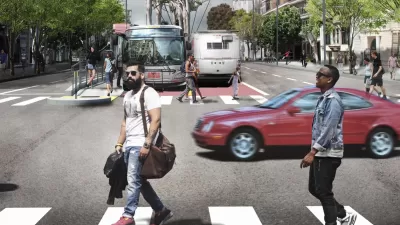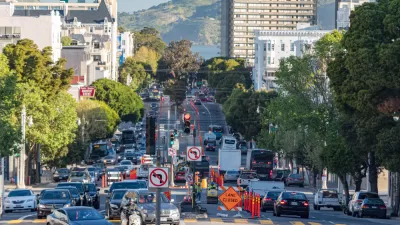The San Francisco rapid bus line is making transit on the corridor more reliable and reducing traffic crashes and congestion.

A Bus rapid transit (BRT) project in San Francisco earned the highest-level designation achieved by U.S. transit projects, Silver, by the Institute for Transportation and Development Policy (ITDP) for its effectiveness in improving transit travel times along the Van Ness corridor.
According to a press release from the city, “The Van Ness project includes dedicated center running transit lanes that don’t get slowed down by parking or turning vehicles, transit signal priority that gives buses the green light as they approach an intersection, as well as low-floor vehicles and all-door boarding, that make it quicker and easier for passengers to load and unload at each stop and fast and frequent operations.”
According to data from the SFMTA, “Bus travel on this corridor is now 36% faster, injury traffic collisions are down by 54%, and transit is 45% more reliable.” The project also added pedestrian bulbouts, countdown signals, and other infrastructure to make walking safer.
Raymone Garner, a Muni Operator of 23 years, said the BRT line “gives us a smoother ride that’s safer with better on-time performance. Riders love it because it’s easier for us to get into the bus zone so it’s easier and safer to pick up passengers, especially people with disabilities.”
The press release adds, “The other BRT Silver-designated projects in the nation include the New Britain Busway in Hartford, Connecticut and the Healthline in Cleveland, Ohio. California has two Bronze projects; the Orange (G) Line in Los Angeles and the sbX E Street Bus BRT in San Bernardino.”
FULL STORY: San Francisco's First Bus Rapid Transit Project Receives Internationally Recognized Designation

Planetizen Federal Action Tracker
A weekly monitor of how Trump’s orders and actions are impacting planners and planning in America.

Restaurant Patios Were a Pandemic Win — Why Were They so Hard to Keep?
Social distancing requirements and changes in travel patterns prompted cities to pilot new uses for street and sidewalk space. Then it got complicated.

Map: Where Senate Republicans Want to Sell Your Public Lands
For public land advocates, the Senate Republicans’ proposal to sell millions of acres of public land in the West is “the biggest fight of their careers.”

Maui's Vacation Rental Debate Turns Ugly
Verbal attacks, misinformation campaigns and fistfights plague a high-stakes debate to convert thousands of vacation rentals into long-term housing.

San Francisco Suspends Traffic Calming Amidst Record Deaths
Citing “a challenging fiscal landscape,” the city will cease the program on the heels of 42 traffic deaths, including 24 pedestrians.

California Homeless Arrests, Citations Spike After Ruling
An investigation reveals that anti-homeless actions increased up to 500% after Grants Pass v. Johnson — even in cities claiming no policy change.
Urban Design for Planners 1: Software Tools
This six-course series explores essential urban design concepts using open source software and equips planners with the tools they need to participate fully in the urban design process.
Planning for Universal Design
Learn the tools for implementing Universal Design in planning regulations.
Heyer Gruel & Associates PA
JM Goldson LLC
Custer County Colorado
City of Camden Redevelopment Agency
City of Astoria
Transportation Research & Education Center (TREC) at Portland State University
Camden Redevelopment Agency
City of Claremont
Municipality of Princeton (NJ)





























